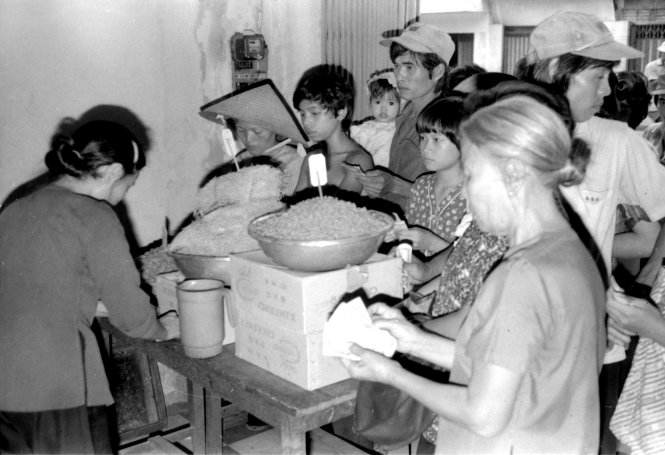Vietnam experienced its hardest peacetime period during the late 1970s and 1980s when even senior leaders did not have enough rice for two meals a day, which was a result of wrong economic and political policies.
>> An audio version of the story is available here
Food shortages hit almost all Vietnamese families, from those of high-ranking officials such as the state bank governor and education minister, to civilians, during the economic stagnation in the country in these two decades.
They did not have enough rice for two meals a day and had to eat rice mixed with white potato, sweet potato, and ‘bo bo,’ which is a kind of black cereal called rye, Job’s tears or sorghum in English.
The rice shortage was later attributed to mistakes in state management in Vietnam, which is now the second biggest rice exporter in the world.
Back then, rice fields traditionally managed by individual farmers were organized into co-operatives, a kind of collective management.
Work and achievements were equally shared to clear the gap between rich people managing vast areas of rice fields and normal peasants.
As a result, farmers had less motivation to work and the output of rice kept going down considerably.
The situation was worsened by the centrally-managed market model that limited the free circulation of goods and farming products between localities nationwide.
It resulted in a scarcity of rice in cities and clothes, fuel, and daily necessities in the countryside.

At a state-owned food shop in Ho Chi Minh City in 1985, the board shows words that read: "... sales of some processed goods..."
In 1979, four years after Vietnam was completely freed from American rule, a serious flood battered the Mekong Delta, the rice granary of Vietnam, further worsening the situation.
Instead of eating rice as the traditional food for generations, Vietnamese people had to eat strange kinds of cereals, including ‘bo bo,' that were given and lent by other nations, such as the former Union of Soviet Socialist Republics (USSR), which is Russia now, and India. Indonesia also lent Vietnam rice in this hard time of malnutrition.
A meal of the education minister, bank governor
In Ho Chi Minh City, the biggest economic hub of the nation, which had never faced a shortage of rice, locals had to ‘get acquainted’ with rice meals mixed with potato and ‘bo bo’ during the dark time.
As the wife of Lu Minh Chau, then-Ho Chi Minh City State Bank Governor and later-Vietnam State Bank Governor, Tran Ngoc Diep recalled that she, her husband, and their children had to eat ‘bo bo’ instead of rice.
As a bank official, Chau was then assigned ‘a second job’ by then-Ho Chi Minh City Party Secretary Vo Van Kiet, who afterward became the prime minister in 1991-97, to look for rice for the city.
Then, a family of six was allocated a quota of some 25kg of rice a month, or 70 grams of rice a meal each person. Smaller families were entitled to 9-13kg of rice a month.
“Adults had to eat other cereals to save rice for the elderly and children in their families,” said an elderly person on recalling the ‘hunger time.’ In many families, adults even ate ‘bo bo’ a whole month.
Doctor Nguyen Van Huy, former director of the Hanoi-based Vietnam Museum of Ethnology, said, “My father Nguyen Van Huyen was then an education minister and our family had to eat ‘bo bo’ instead of rice.

People wait for their turn to buy rice at a state-owned food shop in Ho Chi Minh City in 1985.
“My mother prepared meals for our family of ten members.
“Rice was cooked in the center of the pan and ‘bo bo’ covered its remaining parts.”
A grain of ‘bo bo’ is as big as a human fingertip, much bigger than a rice grain, so it must be scattered around the rim for more cooking heat.
It takes longer time to cook ‘bo bo’ than cooking corn or rice.
The ‘bo bo’ obsession
To cook ‘bo bo,' the cereal must be soaked in water the previous night so that it can be quickly softened during the cooking process.
Yet, most people were worried back then when they were about to eat ‘bo bo’ over its toughness and stiffness.
A person is naturally urged to find something to eat when his stomach is empty, but he cannot secrete enough saliva while chewing ‘bo bo,’ which is often used to distill drinks and tea, or cook sweet soup with just a small amount of ‘bo bo.’
Thus, it takes a long time to be able to get a spoon of ‘bo bo’ through one’s mouth even when they are hungry.
Although an adult was averagely entitled to a quota of nine kilos of rice a month after the liberation year of 1975, they rarely had enough of that amount due to rice shortages.
Later, the quota was lowered to six kilos of rice a person on average.
It was the result of the decreasing rice production in the Mekong Delta. In 1976, the region produced 1.9 million metric tons a year. It went down to 0.99 million metric tons in 1977 and 0.64 million metric tons in 1979.
Like us on Facebook or follow us on Twitter to get the latest news about Vietnam!























































